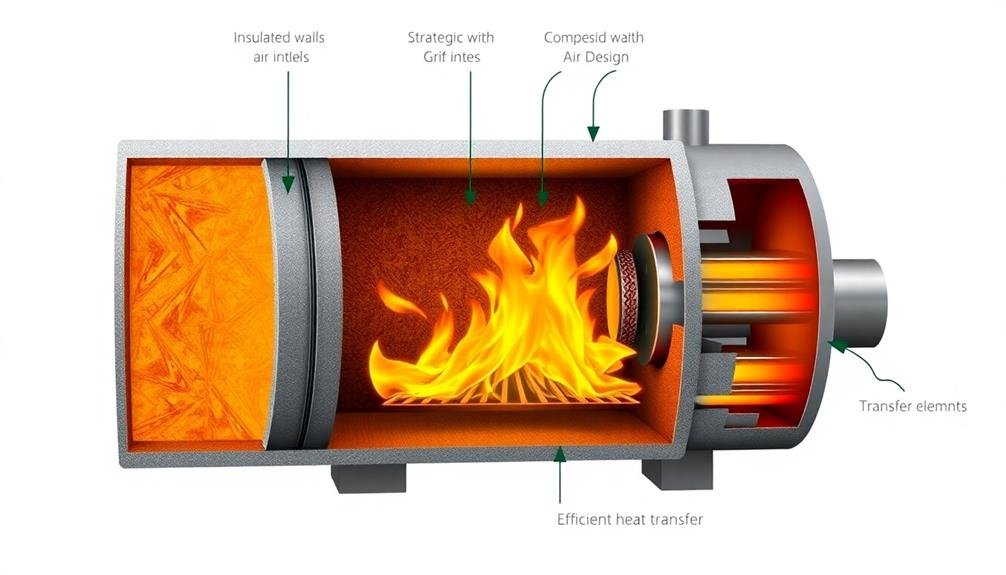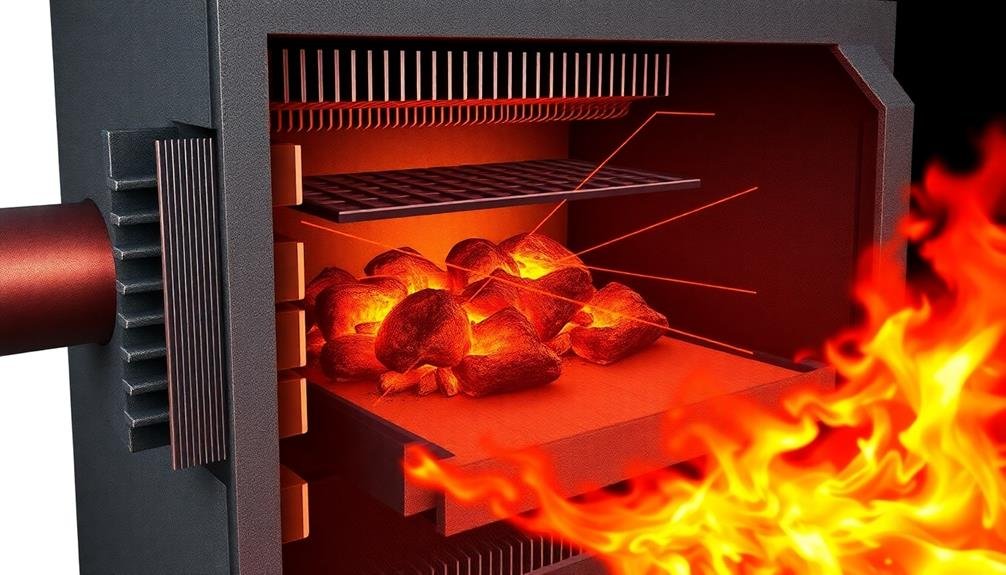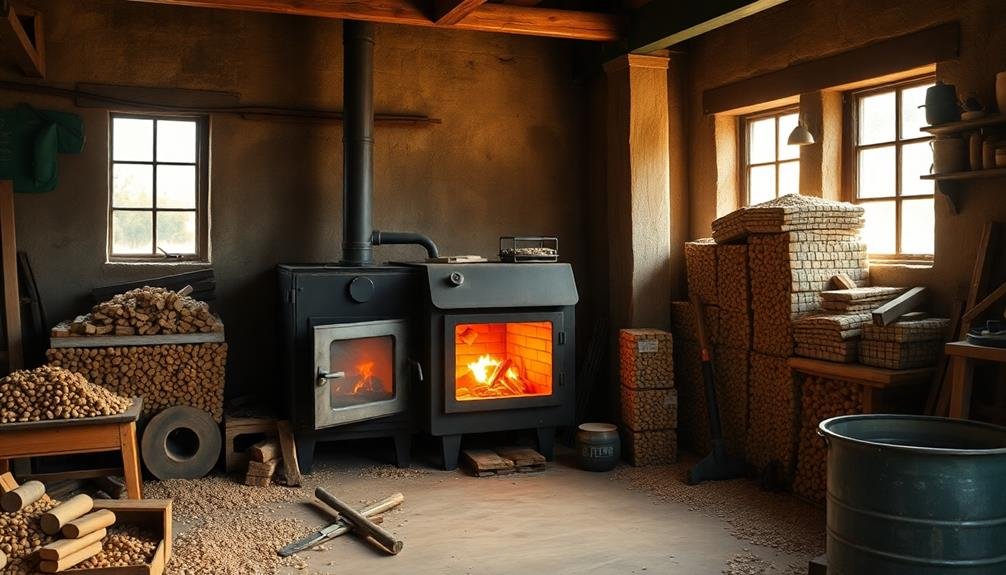To craft your biomass furnace effectively, start by selecting the right biomass material based on availability and energy content. Next, size your furnace appropriately to avoid inefficiencies from over or undersizing. Design an efficient combustion chamber with primary and secondary zones for peak burning. Implement proper ventilation systems, including air intake and exhaust, to guarantee safe operation and maximize efficiency. Finally, enhance heat distribution methods using passive or active techniques to create a comfortable living environment. By following these pro tips, you'll be well on your way to harnessing the full potential of your biomass heating system.
Choose the Right Biomass Material

Selecting the appropriate biomass material is essential for your furnace's efficiency and performance. You'll want to take into account factors like availability, energy content, moisture level, and ash content when choosing your fuel source.
Wood pellets are a popular choice due to their high energy density and low moisture content. They're easy to store and feed into your furnace automatically.
If you're in an agricultural area, crop residues like corn stalks or wheat straw can be viable options. These materials are often abundant but may require additional processing to increase their energy density.
Wood chips are another common biomass fuel, offering a good balance of energy content and cost-effectiveness.
For those near forestry operations, sawdust and wood shavings can be excellent choices. They're typically inexpensive and burn efficiently when properly dried.
Regardless of the material you choose, make sure it's adequately dried to maximize heat output and minimize creosote buildup in your furnace.
Always keep in mind local regulations and sustainability practices when sourcing your biomass fuel. Remember, the right choice will depend on your specific location, budget, and furnace design.
Size Your Furnace Appropriately
Proper sizing is essential when crafting your biomass furnace. You'll need to take into account the space you're heating, the availability of biomass fuel, and your energy needs. Start by calculating the BTU requirements for your home or facility. This involves factoring in the square footage, insulation quality, and climate zone.
Once you've determined your heating needs, select a furnace that can meet those demands without being oversized. An oversized furnace will cycle on and off frequently, reducing efficiency and potentially shortening its lifespan. Conversely, an undersized furnace won't provide adequate heat and may struggle to keep up during peak demand.
Take into account the storage capacity for your biomass fuel as well. You'll want a furnace that can hold enough fuel for extended periods, reducing the frequency of refills. However, verify the storage area doesn't exceed your available space or create safety hazards.
Don't forget to factor in future needs. If you're planning to expand your heated space or increase your energy demands, choose a furnace that can accommodate this growth.
Design an Efficient Combustion Chamber

The heart of your biomass furnace is its combustion chamber. To design an efficient one, focus on optimizing airflow and temperature control.
Start by creating a primary combustion zone where you'll introduce fuel and air. This area should have a grate system to support the burning biomass and allow ash to fall through.
Next, incorporate a secondary combustion zone above the primary area. Here, you'll introduce additional air to burn remaining gases and particles, enhancing efficiency and reducing emissions. Install adjustable air vents in both zones to fine-tune the combustion process.
Choose heat-resistant materials like firebrick or refractory cement for the chamber walls. These materials will withstand high temperatures and reflect heat back into the combustion process.
Shape the chamber to promote turbulence, which helps mix air and fuel thoroughly. Consider adding a baffle system to extend the path of hot gases, maximizing heat transfer to your heating system.
Finally, install a proper chimney or flue to guarantee adequate draft and safe exhaust of combustion gases.
Implement Proper Ventilation Systems
Every biomass furnace needs a well-designed ventilation system to function safely and efficiently. You'll want to focus on three key components: air intake, exhaust, and draft control.
For air intake, install adjustable vents near the bottom of your furnace. These allow you to regulate the amount of oxygen entering the combustion chamber, enhancing the burning process. Position them away from living areas to prevent smoke from entering your home.
The exhaust system is essential for removing harmful gases and particulates. Use a properly sized chimney or flue pipe that extends well above your roofline. Insulate it to maintain high exhaust temperatures, preventing condensation and creosote buildup.
Implement a draft control mechanism to maintain consistent airflow. This can be a damper in the flue pipe or an automated fan system. It'll help you adjust the burn rate and heat output while preventing backdrafts.
Don't forget to include a carbon monoxide detector near your furnace for safety.
Regular cleaning and maintenance of your ventilation system will guarantee peak performance and longevity of your biomass furnace.
Optimize Heat Distribution Methods

With your ventilation system in place, it's time to focus on distributing the heat efficiently throughout your space. Consider using a combination of passive and active heat distribution methods to maximize your biomass furnace's effectiveness.
For passive distribution, strategically place heat-absorbing materials like stone or brick near the furnace. These will slowly release heat over time, creating a more consistent temperature. Install thermal mass floors or walls to further enhance this effect.
Active distribution methods involve using fans or blowers to circulate warm air. Install ceiling fans to push warm air down from the ceiling, and use ductwork to direct heat to specific areas of your space.
Here's a comparison of heat distribution methods:
| Method | Efficiency | Cost | Maintenance |
|---|---|---|---|
| Thermal Mass | High | Low | Low |
| Ceiling Fans | Medium | Low | Low |
| Ductwork | High | High | Medium |
| Radiant Floors | High | High | Low |
| Forced Air | Medium | Medium | Medium |
Remember to insulate your space properly to retain heat and improve overall efficiency. Use weatherstripping around doors and windows, and consider adding extra insulation to walls and ceilings. By optimizing your heat distribution methods, you'll maximize the benefits of your biomass furnace and create a more comfortable living environment.
Frequently Asked Questions
How Often Should I Clean My Biomass Furnace?
You should clean your biomass furnace at least once a month during the heating season. Don't forget to clean the ash pan weekly and inspect the flue regularly. Proper maintenance guarantees peak performance and extends your furnace's lifespan.
Can I Use a Biomass Furnace for Off-Grid Living?
Yes, you can use a biomass furnace for off-grid living. It's an excellent choice for sustainable heating, as you'll rely on renewable resources. You'll need a steady supply of biomass and proper maintenance to guarantee efficient operation.
What Are the Average Installation Costs for a Biomass Furnace?
You'll find biomass furnace installation costs vary widely, ranging from $5,000 to $20,000. Factors like furnace size, type, and your home's setup influence the price. Don't forget to take into account long-term savings on fuel costs.
Are There Government Incentives for Installing a Biomass Furnace?
Yes, you'll find various government incentives for biomass furnace installation. These can include tax credits, grants, and rebates. Check with your local and federal energy agencies to discover what's available in your area. Don't miss out on potential savings!
How Does a Biomass Furnace Compare to Traditional Heating Systems in Efficiency?
You'll find biomass furnaces can be as efficient as traditional heating systems, often reaching 80-90% efficiency. They're carbon-neutral and use renewable fuels, but may require more maintenance and space than conventional systems.
In Summary
You've now got the key tips to craft an effective biomass furnace. Remember to choose your fuel wisely, size your furnace correctly, and design an efficient combustion chamber. Don't forget proper ventilation and heat distribution methods. With these strategies, you'll create a furnace that's both eco-friendly and efficient. Keep experimenting and refining your design. You're on your way to mastering biomass heating technology and reducing your carbon footprint.





Leave a Reply